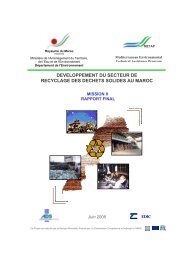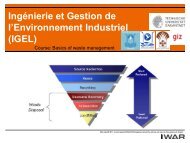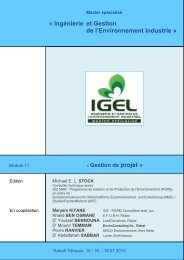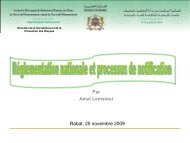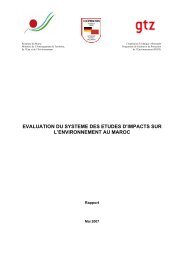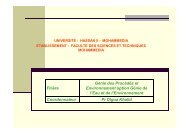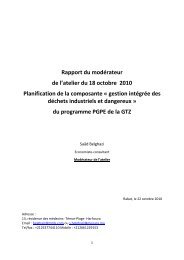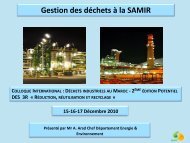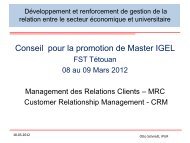Ingénierie et Gestion de l'Environnement Industriel ... - GD MAROC
Ingénierie et Gestion de l'Environnement Industriel ... - GD MAROC
Ingénierie et Gestion de l'Environnement Industriel ... - GD MAROC
You also want an ePaper? Increase the reach of your titles
YUMPU automatically turns print PDFs into web optimized ePapers that Google loves.
Ingénierie <strong>et</strong> <strong>Gestion</strong> <strong>de</strong>l’Environnement <strong>Industriel</strong>(IGEL)Course: Basics of waste managementhttp://earth911.com/news/2009/03/09/waste-hierarchy-whos-on-top-in-the-game-of-trash/
Unit 4: Waste ManagementContent1. Task (dévoirs)2. How to come to a (municipal) waste mangement concept/plan(création d‟un plan <strong>de</strong> gestion <strong>de</strong> déch<strong>et</strong>s)3. Circular Economy as a background for waste mangement(recirculation <strong>de</strong> la liqueur mixte)4. Practice of waste mangement in Europe(application <strong>de</strong> gestion <strong>de</strong>s déch<strong>et</strong>s en Europe)4.1 Collection and Transport (collect <strong>et</strong> transport)4.2 Recovery (récuperation)4.3 Recycling (recyclage)4.4 Treatment and Disposal (treatement <strong>et</strong> stockage)4.5 Site Selection5. Case Study North-Rhine Westphalia6. Summary12/01/2012 | Group of waste management and waste technology| Institute IWAR | Prof. Dr. Uwe Lahl 2
Unit 4: Waste Management1 TaskTask12/01/2012 | Group of waste management and waste technology| Institute IWAR | Prof. Dr. Uwe Lahl 3
Unit 4: Waste Management1 TaskPour n<strong>et</strong>toyer les déch<strong>et</strong>s il faut savoir les components concernant la qualité <strong>et</strong> la composition (propriété physical <strong>et</strong>chemical) Cela est nécessaire pour la construction d‟un équipement <strong>de</strong> déch<strong>et</strong>s. Il faut distinguer entre déch<strong>et</strong>s <strong>de</strong>sménages commercial <strong>et</strong> déch<strong>et</strong>s <strong>de</strong>s entreprises. <strong>de</strong> la liqueur mixteInvent 200912/01/2012 | Group of waste management and waste technology| Institute IWAR | Prof. Dr. Uwe Lahl 4
Unit 4: Waste Management1 TaskHousehold waste logistics:Storage/Collection/TransportMunicipal WasteManagementWaste characteristics:Definitions/Waste characteristics/Waste separation techniques for recyclingWaste treatment techniques:Biological waste treatment (composting, <strong>et</strong>c)Mechanical-biological waste treatmentCase study – waste management in IndonesiaIndustrial WasteManagementWaste treatment techniques:IncinerationLand filling12/01/2012 | Group of waste management and waste technology| Institute IWAR | Prof. Dr. Uwe Lahl 5
Unit 4: Waste Management1 TaskDéch<strong>et</strong>s, primièrement <strong>de</strong>ménages privés, associé avecla collection municipal <strong>et</strong> privéedéch<strong>et</strong>s <strong>de</strong> établissement commercial,d„industries qui est comparable en leur qualitéavec les déch<strong>et</strong>s <strong>de</strong> ménagesDéch<strong>et</strong>s <strong>de</strong> marchés par exemple les légumes, les fruits <strong>et</strong> <strong>de</strong>s matériaux non-réutlisableDéch<strong>et</strong>s collecté pendant la n<strong>et</strong>toiement urbanInvent 200912/01/2012 | Group of waste management and waste technology| Institute IWAR | Prof. Dr. Uwe Lahl 6
Unit 4: Waste Management1 TaskLes activités <strong>de</strong> la gestion <strong>de</strong>s déch<strong>et</strong>s en <strong>de</strong>ux intentions:a) Il faut collecter régulièrement les déch<strong>et</strong>s ménages, urbains <strong>et</strong> municipauxb) Les déch<strong>et</strong>s collectés doivent être éliminés d'une manière qu'il n'affectepas l'environnementInvent 200912/01/2012 | Group of waste management and waste technology| Institute IWAR | Prof. Dr. Uwe Lahl 7
Unit 4: Waste Management1 TaskÀ côté <strong>de</strong> mesures organisatrices, structurales <strong>et</strong> techniques à la gestion <strong>de</strong>s déch<strong>et</strong>s il faut consi<strong>de</strong>rer:Invent 200912/01/2012 | Group of waste management and waste technology| Institute IWAR | Prof. Dr. Uwe Lahl 8
Unit 4: Waste Management1 TaskInvent 200912/01/2012 | Group of waste management and waste technology| Institute IWAR | Prof. Dr. Uwe Lahl 9
Unit 4: Waste Management1 Taskhttp://www.gd-maroc.info/fileadmin/user_files/pdf/manuel/CONCEPTS-GESTION-DECHETS/4-4-Notices-Prevention.pdf12/01/2012 | Group of waste management and waste technology| Institute IWAR | Prof. Dr. Uwe Lahl10
Unit 4: Waste Management1 TaskInvent 200912/01/2012 | Group of waste management and waste technology| Institute IWAR | Prof. Dr. Uwe Lahl 11
Unit 4: Waste Management2 Waste Management ConceptWaste Management Concept12/01/2012 | Group of waste management and waste technology| Institute IWAR | Prof. Dr. Uwe Lahl 12
Unit 4: Waste Management2 Waste Management ConceptInvent 200912/01/2012 | Group of waste management and waste technology| Institute IWAR | Prof. Dr. Uwe Lahl 13
Unit 4: Waste Management2 Waste Management Concept• Waste management concept– What is a waste management concept?• It shows directions and strategies of the waste management in atarg<strong>et</strong> area.(montre la situation actuelle <strong>de</strong> la gestion déch<strong>et</strong>s)• The aim of the concept is to reduce the waste generation and tooptimize the waste recycling(But du plan est <strong>de</strong> réduire la generation <strong>de</strong> déch<strong>et</strong>s <strong>et</strong> d‟optimaliser le recyclage <strong>de</strong> déch<strong>et</strong>s)• To guarantee the best treatment for the generated waste(le meilleure traitement <strong>de</strong> déch<strong>et</strong>s)umweltbun<strong>de</strong>samt: Best Practice of Municipal Waste Management12/01/2012 | Group of waste management and waste technology| Institute IWAR | Prof. Dr. Uwe Lahl 14
Unit 4: Waste Management2 Waste Management ConceptIn or<strong>de</strong>r to build a waste management plan/concept on a national, regional orlocal level, the respective tasks and activities to be tackled have to be based oneffective and systematic planning. A waste management plan has to beelaborated that s<strong>et</strong>s out an analysis of the current waste management situationin the geographical entity concerned, as well as the measures to be taken toimprove environmentally sound preparing for re-use, recycling, recovery anddisposal of waste.Pour construir une gestion <strong>de</strong>s déch<strong>et</strong>s national, regional ou local il faut la planifier systématique en détails. Le plan d„une gestion <strong>de</strong>s déch<strong>et</strong>sdoit être m<strong>et</strong>rre au point <strong>de</strong> gestion <strong>de</strong>s déch<strong>et</strong>s actuelle.recirculation <strong>de</strong> la liqueur mixteGIZ: Draft „Manual Industrial Waste Management for Low and Midlle Income Economies“12/01/2012 | Group of waste management and waste technology| Institute IWAR | Prof. Dr. Uwe Lahl 15
Unit 4: Waste Management2 Waste Management ConceptAnalysis of the current waste management situation including anassessment of:•Types, quantities and sources of waste generated within the area; import an<strong>de</strong>xport of waste from and to other regions•Existing waste collection schemes and major disposal and recoveryinstallations•Arrangements ma<strong>de</strong> for special waste streams (e.g. hazardous industrialwaste, waste oil, health care waste, waste electrical and electronic equipment,construction and <strong>de</strong>molition waste, end of life vehicles)Pour analyser la gestion <strong>de</strong> déch<strong>et</strong>s auctuelle il faut estimer:les types, les quantité <strong>et</strong> les sources <strong>de</strong> déch<strong>et</strong>s;l„import <strong>et</strong> l„export <strong>de</strong> déch<strong>et</strong>s entre <strong>de</strong> régions différentesSchémas <strong>de</strong> collecter <strong>de</strong> déch<strong>et</strong>s, d„un meilleur stockage <strong>et</strong> <strong>de</strong>s institutions <strong>de</strong> réutilisationGIZ: Draft „Manual Industrial Waste Management for Low and Midlle Income Economies“12/01/2012 | Group of waste management and waste technology| Institute IWAR | Prof. Dr. Uwe Lahl 16
Unit 4: Waste Management2 Waste Management ConceptElements in a waste management plan (EU)Background1. Overall waste problematics2. EU legislation3. National legislation4. Description of national waste policy and prevailingprinciples5. Description of objectives s<strong>et</strong> up in specific areas6. Inputs from the consultation processStatus part1. Waste amounts, e.g.a) waste streamsb) waste sourcesc) waste management options2. Waste collection and treatment3. Economy and financing4. Assessment of previous objectivesPlanning part1. Assumptions for planning2. D<strong>et</strong>ermination of objectives, e.g. fora) waste streamsb) waste sourcesc) waste management options3. Plan of action, including measuresfor achieving objectivesa) collection systemsb) waste management facilitiesc) responsibilitiesd) economy and financingEC: Preparing a Waste Mangement Plan, 200312/01/2012 | Group of waste management and waste technology| Institute IWAR | Prof. Dr. Uwe Lahl 17
Unit 4: Waste Management2 Waste Management ConceptEC 200312/01/2012 | Group of waste management and waste technology| Institute IWAR | Prof. Dr. Uwe Lahl 18
Unit 4: Waste Management2 Waste Management ConceptPrognosis of future waste generationAssessment of future requirements such asD<strong>et</strong>ermination of the future disposal capacity nee<strong>de</strong>dClosure of existing waste recovery and disposal installationsAdditional disposal and recovery installations and their capacities, locationsand the investments related ther<strong>et</strong>oNew collection schemesWaste management policiesBefore starting the planning, the scope of the plan must be <strong>de</strong>fined. Thisinclu<strong>de</strong>s consi<strong>de</strong>ration of the following issues:What is the geographical coverage of the plan? National, regional or local?Which waste streams will be inclu<strong>de</strong>d or respectively exclu<strong>de</strong>d in the plan?Which industrial sectors will be inclu<strong>de</strong>d or respectively exclu<strong>de</strong>d in the plan?What is the time horizon of the plan? e.g. 5, 10, 15 or 20 years?GIZ: Draft „Manual Industrial Waste Management for Low and Midlle Income Economies“12/01/2012 | Group of waste management and waste technology| Institute IWAR | Prof. Dr. Uwe Lahl 19
Unit 4: Waste Management2 Waste Management Concept• Waste management concept – construction– Formulating the aims of the concept– Obtaining an overview of the current waste management situation– Evaluating the current situation• Potentials of waste prevention and waste reduction?• B<strong>et</strong>ter disposal opportunities?• The prognosis of the <strong>de</strong>velopment of waste generation– Planning a new conceptumweltbun<strong>de</strong>samt: Best Practice of Municipal Waste Management12/01/2012 | Group of waste management and waste technology| Institute IWAR | Prof. Dr. Uwe Lahl 20
Unit 4: Waste Management2 Waste Management Concept• Waste management concept – Formulating the aims of the concept– Defining the size of the planning area– D<strong>et</strong>ermining cities involved in the management• Collection, Transport, Treatment,...– Looking for the traffic situation– Grasping an overview of organisations involved– Estimating time and finances requiredumweltbun<strong>de</strong>samt: Best Practice of Municipal Waste Management12/01/2012 | Group of waste management and waste technology| Institute IWAR | Prof. Dr. Uwe Lahl 21
Unit 4: Waste Management2 Waste Management Concept• Waste management concept – Overview of the current waste management situation– Area characterisation (le caractère <strong>de</strong> la région)• Population• Building structure• Commercial/industrial structure– Waste management structure (la structure <strong>de</strong> la gestion <strong>de</strong> déch<strong>et</strong>s)• Current amount of the waste and prognosis• Collection and transport– Separation of different wastes (glass, organic, paper,...)• Cost of waste management system• Are constructions of waste treatment facilities un<strong>de</strong>rway?umweltbun<strong>de</strong>samt: Best Practice of Municipal Waste Management12/01/2012 | Group of waste management and waste technology| Institute IWAR | Prof. Dr. Uwe Lahl 22
Unit 4: Waste Management2 Waste Management ConceptWaste management concept – Overview of the current waste management situation(la gestion <strong>de</strong> déch<strong>et</strong>s acutelle)– Situation on the material/energy mark<strong>et</strong>• Recycled material• Energy and heat recovered from “waste-to-energy” plants• Compost• ...umweltbun<strong>de</strong>samt: Best Practice of Municipal Waste Management12/01/2012 | Group of waste management and waste technology| Institute IWAR | Prof. Dr. Uwe Lahl 24
Unit 4: Waste Management2 Waste Management ConceptWaste management concept – Evaluation– Quantity» Optimize the waste prevention and recycling process(optimier l‟évitation <strong>de</strong> déch<strong>et</strong>s <strong>et</strong> <strong>de</strong> procès du recyclage)– Quality» Reduce of products with a short life-cycle with a high risk forthe environment (prevention and reducing of hazardous wastegeneration)(réduire les produits qui font une gran<strong>de</strong> risque pour l‟environnement)umweltbun<strong>de</strong>samt: Best Practice of Municipal Waste Management12/01/2012 | Group of waste management and waste technology| Institute IWAR | Prof. Dr. Uwe Lahl 26
Unit 4: Waste Management2 Waste Management ConceptWaste management concept – EvaluationLe concept <strong>de</strong> la gestion <strong>de</strong> déch<strong>et</strong>s– Prognosis of the amount and composition of the waste• Param<strong>et</strong>ers that influence the <strong>de</strong>velopment of the waste composition(montre toutes influences <strong>de</strong> développement concernant la composition <strong>de</strong> déch<strong>et</strong>s)• Economic <strong>de</strong>velopment(le <strong>de</strong>veloppement économique)• Prognosis of the future amount of waste(les prévisions au futur concernant les déch<strong>et</strong>s)umweltbun<strong>de</strong>samt: Best Practice of Municipal Waste Management12/01/2012 | Group of waste management and waste technology| Institute IWAR | Prof. Dr. Uwe Lahl 28
Unit 4: Waste Management2 Waste Management ConceptFor implementation of an effective wastemanagement system, you have to know all:-Natural conditions (les conditions naturals)-Demographic conditions (les conditions démographiques)-Structural conditions (les conditions structurals)-Technical conditions (les conditions techniques)-Economical conditions (les conditions économique)-And legal requirementsYou have to know the strengths and weaknesses ofeach condition of the planning area.Based on the information, you have to calculate andplan your waste management system with selectedmeasures and technologies.Ces conditions offrent la possibilité <strong>de</strong> calculer <strong>et</strong> planifièr la gestion <strong>de</strong> déch<strong>et</strong>s avec sesMesures <strong>et</strong> ses technologies.umweltbun<strong>de</strong>samt: Best Practice of Municipal Waste Management12/01/2012 | Group of waste management and waste technology| Institute IWAR | Prof. Dr. Uwe Lahl29
Unit 4: Waste Management2 Waste Management Concept• For <strong>de</strong>scribing a special area you have to <strong>de</strong>al with certain criteria• Stratification criteria inclu<strong>de</strong>:1 structure of dwelling2 structure of heating3 commercial structure4 transport n<strong>et</strong>work5 industrial structure6 regional particularitiesumweltbun<strong>de</strong>samt: Best Practice of Municipal Waste Management12/01/2012 | Group of waste management and waste technology| Institute IWAR | Prof. Dr. Uwe Lahl 30
Unit 4: Waste Management2 Waste Management ConceptInclu<strong>de</strong> the informal sectorhttp://pswm.uvic.ca/en/welcome/in<strong>de</strong>x.html12/01/2012 | Group of waste management and waste technology| Institute IWAR | Prof. Dr. Uwe Lahl 31
Unit 4: Waste Management2 Waste Management ConceptFind solutions with the informal sector12/01/2012 | Group of waste management and waste technology| Institute IWAR | Prof. Dr. Uwe Lahl 32http://pswm.uvic.ca/en/welcome/in<strong>de</strong>x.html
Unit 4: Waste Management2 Waste Management ConceptFind solutions with the informal sectorhttp://pswm.uvic.ca/en/welcome/in<strong>de</strong>x.html12/01/2012 | Group of waste management and waste technology| Institute IWAR | Prof. Dr. Uwe Lahl 33
Unit 4: Waste Management2 Waste Management Concepthttp://pswm.uvic.ca/en/welcome/in<strong>de</strong>x.html12/01/2012 | Group of waste management and waste technology| Institute IWAR | Prof. Dr. Uwe Lahl 34
Unit 4: Waste Management2 Waste Management ConceptGUIDECONCEPTS DEGESTION ETBILANS DESDECHETShttp://www.gd-maroc.info/in<strong>de</strong>x.php?id=11512/01/2012 | Group of waste management and waste technology| Institute IWAR | Prof. Dr. Uwe Lahl35
Unit 4: Waste Management2 Waste Management Concepthttp://www.gd-maroc.info/fileadmin/user_files/pdf/manuel/CONCEPTS-GESTION-DECHETS/2-1-2-Flux-module2-collecte-donees-evaluation.pdf12/01/2012 | Group of waste management and waste technology| Institute IWAR | Prof. Dr. Uwe Lahl36
Unit 4: Waste Management2 Waste Management ConceptLa <strong>Gestion</strong> <strong>de</strong>s Flux <strong>de</strong>s Matières – Bilan <strong>de</strong> Déch<strong>et</strong>sUn bilan sera mieux présenté sous forme <strong>de</strong> tableau. Par exemple lafabrication <strong>de</strong> circuits imprimés (Déch<strong>et</strong>s provenant du TraitementChimique <strong>de</strong> surface ……)http://www.gd-maroc.info/fileadmin/user_files/pdf/manuel/CONCEPTS-GESTION-DECHETS/2-1-2-Flux-module42-bilans-<strong>de</strong>ch<strong>et</strong>s.pdf12/01/2012 | Group of waste management and waste technology| Institute IWAR | Prof. Dr. Uwe Lahl37
EnergyRecoveryRemanufacturerMaterials Recovery FacilityEnergyRecoveryRemanufacturerUnit 4: Waste Management2 Waste Management ConceptHouseholdsElectronicWasteBulkyWasteHazardousWasteOrganicWasteResidualWastePackagingWasteGlassPaperTextilesCollection in Waste CentresHazardousLandfillMaterials Recovery andDisassembly FacilityFe-M<strong>et</strong>alsKerbsi<strong>de</strong> CollectionCompostingFacilityMaterial BankCollection and Waste CentresRemanufacturerNGOBeverageContainersHDPEConcept for aMunicipality, fluxdiagramNe-M<strong>et</strong>alsCompostLDPEGlassPlasticsOrganic Material(e.g. Wood)LandfillPETFe-M<strong>et</strong>alsNe-M<strong>et</strong>alsMiscellaneousMiscellaneousMechanical Biological Treatment(Herhof System)Dry StabilatePell<strong>et</strong>sFe-M<strong>et</strong>alsNe-M<strong>et</strong>alsBatteriesMineralFractionLandfillEnergyRecoveryRemanufacturerSince 2001Winkler J., Bilitewski B. 200512/01/2012 | Group of waste management and waste technology| Institute IWAR | Prof. Dr. Uwe Lahl 38
Unit 4: Waste Management2 Waste Management ConceptEC200312/01/2012 | Group of waste management and waste technology| Institute IWAR | Prof. Dr. Uwe Lahl 39
Unit 4: Waste Management3 Concept circular economyConcept circular economy12/01/2012 | Group of waste management and waste technology| Institute IWAR | Prof. Dr. Uwe Lahl40
Unit 4: Waste Management3 Concept circular economyBlack board: Explain the basic i<strong>de</strong>aFROM WASTE MANAGEMENT TO CIRCULARECONOMY12/01/2012 | Group of waste management and waste technology| Institute IWAR | Prof. Dr. Uwe Lahl 41
ProductionW,C,H,R,T,I,OWaste generationW,C,H,R,I,OWaste disposalW,C,H,S,R,I,ORaw materialsProductionConsumption2020Collection/TransportW,C,T,R,I,OWast<strong>et</strong>reatmentLandfill disposalWaste utilisationW,C,H,S,R,I,OWast<strong>et</strong>reatmentW,C,H,S,R,I,OW Waste Management LawA1 Recycling Management andWaste Act (KrW-AbfG)A2 Electric and electronic equipmentOrdinance (ElektroG)A3 Act for the disposal of animalremains (TierkörperbeseitigungsG)A4 Ordinance on waste export andtransportation (AbfallverbringungsG)A5 Ordinance on end-of-life vehicles(AltfahrzeugG).........A6 Packaging Ordinance (VerpackungsV)A7 Landfill Ordinance (DeponieV)A8 Ordinance on commercial waste(GewerbeabfallV)A9 Ordinance on biowaste (BioabfallV)A10 Ordinance on used batteries(BatterieV)A11 Ordinance on waste <strong>de</strong>position(AbfallablagerungsV)A12 Ordinance on evi<strong>de</strong>nce provision.............C Criminal lawT Traffic lawsH Laws on waterS Laws on soilR Laws on hazardous substancesI Law for immission preventionand controlO Law on occupational saf<strong>et</strong>yand health12/01/2012 | Group of waste management and waste technology| Institute IWAR | Prof. Dr. Uwe Lahl 42
Unit 4: Waste Management3 Concept circular economyMark<strong>et</strong> based Circular Economy12/01/2012 | Group of waste management and waste technology| Institute IWAR | Prof. Dr. Uwe Lahl 43
Unit 4: Waste Management3 Concept circular economycost0 % 50 % 100 %Recyclinghandled waste100 % 50 % 0 %Billitewski 201012/01/2012 | Group of waste management and waste technology| Institute IWAR | Prof. Dr. Uwe Lahl 44
Unit 4: Waste Management3 Concept circular economycostvirginmaterialcost0 %100 %50 %Recyclinghandled waste50 %100 %0 %Billitewski 201012/01/2012 | Group of waste management and waste technology| Institute IWAR | Prof. Dr. Uwe Lahl 45
Unit 4: Waste Management3 Concept circular economycostrecyclingcostvirginmaterialcost0 %50 % 100 %Recyclinghandled waste100 % 50 % 0 %Billitewski 201012/01/2012 | Group of waste management and waste technology| Institute IWAR | Prof. Dr. Uwe Lahl 46
Unit 4: Waste Management3 Concept circular economycostBrecyclingcostvirginmaterialcostOpt. 10 % 50 % 100 %Recyclinghandled waste100 % 50 % 0 %BResulting slope of virgin material cost andrecycling costBillitewski 201012/01/2012 | Group of waste management and waste technology| Institute IWAR | Prof. Dr. Uwe Lahl 47
Unit 4: Waste Management3 Concept circular economycostBWastemanagement costrecyclingcostrcyclingcostvirginmaterialcostOpt. 10 % 50 % 100 %Recyclinghandled waste100 % 50 % 0 %BResulting slope of virgin material cost andrecycling costBillitewski 201012/01/2012 | Group of waste management and waste technology| Institute IWAR | Prof. Dr. Uwe Lahl 48
Unit 4: Waste Management3 Concept circular economycostA Resulting slope with wastemanagement costWastemanagementcost0 %B50 %RecyclingAOpt. 1Brecyclingcostvirginmaterial cost100 %Opt. 2Resulting slope of virgin materialcost and recycling cost100%50 %handledwaste0 %Billitewski 201012/01/2012 | Group of waste management and waste technology| Institute IWAR | Prof. Dr. Uwe Lahl 49
Unit 4: Waste Management3 Concept circular economyRecommendations for Circular Economy Development• Total Vision of Material Cycle Economy• Development integrated with Resources, Energy & EnvironmentPreservation and Economic Growth• Efficient Utilization of Secondary Resources• Beneficial Effects on Technology, Economy and Employment• System Developments using Hierarchical Approach– Prevention, Reuse, Recycle, Treatment & Disposal– Development of Material Cycle In<strong>de</strong>x and Basic Statistics– Global-scale N<strong>et</strong>work of Material Cycles is essential Billitewski 201012/01/2012 | Group of waste management and waste technology| Institute IWAR | Prof. Dr. Uwe Lahl 50
Unit 4: Waste Management3 Concept circular economyRecommendations for Circular Economy Development• Integrated Approach with Policy Development,Material Cycle Technologies & Funding Mechanism– Individual Material Cycle Systems• Container & Packaging• Home Appliances• End-of-Life Vehicles• Other Products• Recycling Residue Management and its InfrastructureBuilding– Without Residue Management Infrastructure, Local and Global PollutionBillitewski 201012/01/2012 | Group of waste management and waste technology| Institute IWAR | Prof. Dr. Uwe Lahl 51
Unit 4: Waste Management4 PracticePractice12/01/2012 | Group of waste management and waste technology| Institute IWAR | Prof. Dr. Uwe Lahl52
Unit 4: Waste Management4 PracticeDiscuss with the class the topic: From concepts to practicehttp://openlearn.open.ac.uk/mod/oucontent/view.php?id=399300§ion=4.212/01/2012 | Group of waste management and waste technology| Institute IWAR | Prof. Dr. Uwe Lahl 53
Unit 4: Waste Management4 Practicehttp://wanless.com.au/images/What_is_waste_Management/Waste-Management-Process-10-x-10V2.jpg12/01/2012 | Group of waste management and waste technology| Institute IWAR | Prof. Dr. Uwe Lahl54
Unit 4: Waste Management4 PracticeTransport and Collection12/01/2012 | Group of waste management and waste technology| Institute IWAR | Prof. Dr. Uwe Lahl55
Unit 4: Waste Management4 Practice• Collection and transport are important parts of the primary targ<strong>et</strong> tohandle generated waste (material and energy recovery)(La coellection <strong>et</strong> le transport sont important pour le traitement <strong>de</strong> déch<strong>et</strong>s)• To pursue the goal of the waste management, the waste has to becollectable and transportable(Pour réaliser ce but les déch<strong>et</strong>s doivent être collectionable)• Collection in bins and containers• Transport with special vehicles (Front loa<strong>de</strong>r, si<strong>de</strong> loa<strong>de</strong>r,…)umweltbun<strong>de</strong>samt: Best Practice of Municipal Waste Management12/01/2012 | Group of waste management and waste technology| Institute IWAR | Prof. Dr. Uwe Lahl 56
Unit 4: Waste Management4 Practice• Task of waste collection:• Collection of all household, industrial and commercial wastes• Separation of recyclable waste from non-recyclable waste• Picking up the waste from the place of their collection• Task of waste transport:• Transport wastes to the processing and disposal facilities• Storage of the collected waste in the vehicles• The collection and transport of waste takes 60-80 % of the total costs fordisposal(La collection <strong>et</strong> le transport font 60-80% du coûts total pour le stockage)umweltbun<strong>de</strong>samt: Best Practice of Municipal Waste Management12/01/2012 | Group of waste management and waste technology| Institute IWAR | Prof. Dr. Uwe Lahl 57
Unit 4: Waste Management4 Practice• For implementation of a waste collection and transport system, thefollowing aspects should be consi<strong>de</strong>red:(Pour la collection <strong>et</strong> le transport il faut savoir:)• Dimension of the collecting area(la dimension <strong>de</strong> la région)• Structural, economic and social s<strong>et</strong>tings• Area specific legislative stipulations• User <strong>de</strong>mands• The spectrum of appropriate collection systems and technologiesumweltbun<strong>de</strong>samt: Best Practice of Municipal Waste Management12/01/2012 | Group of waste management and waste technology| Institute IWAR | Prof. Dr. Uwe Lahl 58
Unit 4: Waste Management4 Practice• Collection systems:• Pick-up arrangement system• Drop-off arrangement or bring systemUmweltbun<strong>de</strong>samt: Best Practice of Municipal Waste Management12/01/2012 | Group of waste management and waste technology| Institute IWAR | Prof. Dr. Uwe Lahl59
Unit 4: Waste Management4 Practice• M<strong>et</strong>hods for picking-up the waste:• Simple container emptying• Container exchange• One way• Simple container emptying:• The collected waste in bins or containers is picked up at the privatehouseholds using a mechanical emptying system(les déch<strong>et</strong>s sont collectés <strong>de</strong> chaques ménagers <strong>et</strong> les collecteurs les m<strong>et</strong>tent dans une container)• Container exchange:• The container filled up with waste is picked up and replaced with a emptycontainer(Le container plein va changer avec un qui est vi<strong>de</strong>)umweltbun<strong>de</strong>samt: Best Practice of Municipal Waste Management12/01/2012 | Group of waste management and waste technology| Institute IWAR | Prof. Dr. Uwe Lahl 60
Unit 4: Waste Management4 Practice• One way m<strong>et</strong>hod:• The waste is picked up in special containers or big bags. Bags are alsotreated as wastesles déch<strong>et</strong>s sont collectés dans <strong>de</strong>s sacs spécialsSimply container emptyingemptyContainer exchangefullhttp://www.abfallwirtschaft-hohenlohekreis.<strong>de</strong>http://www.fischersoehne.<strong>de</strong>/container/container_aufla<strong>de</strong>n.jpg12/01/2012 | Group of waste management and waste technology| Institute IWAR | Prof. Dr. Uwe Lahl61
Unit 4: Waste Management4 Practice• Difference b<strong>et</strong>ween transportation on short and long distances(differnce entre <strong>de</strong> véhicules pour transporter les déch<strong>et</strong>s sur une distance longues ou courte)• For short distance transportation, the vehicles that collect the waste also transportthe waste to next station (e.g. treatment facility, transfer station, landfill).(les véhicules pour les distances courte sont les mêmes comme les véhicules pour collecter les déch<strong>et</strong>s)• For long distance transportation, different vehicles are used for picking-up wastesand for transport the picked-up waste .• Special vehicles for the transportation and transportation pathways have tobe prepared(Pour le transport long il faut avoir <strong>de</strong> véhicules <strong>et</strong> <strong>de</strong> routes spéciales)• Before transporting the wastes, they are brought to the „transfer stations“ fora short storage and the first treatment(Avant le transport longue <strong>de</strong> déch<strong>et</strong>s commence ils sont déposés dan un station <strong>de</strong> transfer -> le premier traitementumweltbun<strong>de</strong>samt: Best Practice of Municipal Waste Management12/01/2012 | Group of waste management and waste technology| Institute IWAR | Prof. Dr. Uwe Lahl 62
Unit 4: Waste Management4 Practice• Waste transportation can be distinguished by as follows:• Types of employed transportation vehicles• Container system or truck body used• Transporting the waste using a vehicle with or without a compaction system• Mostly ships or trains are used for long-distance transportations• The advantage is the maximum loading capacity. A truck can take up to 25Mg, a train 1000 Mg and a riverboat up to 500-3000 Mg.• The emission rate and environmental impact is lowerumweltbun<strong>de</strong>samt: Best Practice of Municipal Waste Management12/01/2012 | Group of waste management and waste technology| Institute IWAR | Prof. Dr. Uwe Lahl 63
Unit 4: Waste Management4 Practice• Transport vehicles:• Rear-end loa<strong>de</strong>d refuse collection vehicle• Front loa<strong>de</strong>d refuse collection vehicle• Si<strong>de</strong> loa<strong>de</strong>d collection vehicle• Swap body container systemumweltbun<strong>de</strong>samt: Best Practice of Municipal Waste Management12/01/2012 | Group of waste management and waste technology| Institute IWAR | Prof. Dr. Uwe Lahl 64
Unit 4: Waste Management4 Practice• Transport Vehicles:• Rear-end loa<strong>de</strong>d refuse collection vehicleUweltbun<strong>de</strong>samt: Best Practice of Municipal Waste Management12/01/2012 | Group of waste management and waste technology| Institute IWAR | Prof. Dr. Uwe Lahl 65
Unit 4: Waste Management4 Practice• Rear-end loa<strong>de</strong>d refuse collection vehicle:• Technical scheme:• The waste is loa<strong>de</strong>d in bags or containers in the rear-end of the vehicle• Compaction system compresses the waste• If the vehicle is full, the waste is brought to the disposal facility• For collection of different kinds of wastes, there are “double body vehicles”(umweltbun<strong>de</strong>samt: Best Practice of Municipal Waste Management)12/01/2012 | Group of waste management and waste technology| Institute IWAR | Prof. Dr. Uwe Lahl 66
Unit 4: Waste Management4 Practiceumweltbun<strong>de</strong>samt: Best Practice of Municipal Waste Management12/01/2012 | Group of waste management and waste technology| Institute IWAR | Prof. Dr. Uwe Lahl 67
Unit 4: Waste Management4 Practice• Front loa<strong>de</strong>d refuse collection vehicle:www.faun.com12/01/2012 | Group of waste management and waste technology| Institute IWAR | Prof. Dr. Uwe Lahl 68
Unit 4: Waste Management4 Practice• Front loa<strong>de</strong>d refuse collection vehicle:• Technical scheme:• The basic parts of these vehicles are: the chassis, the body with a compactionsystem, the hopper and the front lifting <strong>de</strong>vice• With the lifting <strong>de</strong>vice (behind the drivers cabin) the containers are lifted in thevehicle• With a comb- or a pock<strong>et</strong> system, the bins or containers are fixed on the lifting arms• With a mechanical compaction system, the waste is compressed in the vehicle• If the vehicle is filled up, the waste is transported to the disposal facility. At thefacility the waste will be discharged by opening the rear.Uweltbun<strong>de</strong>samt: Best Practice of Municipal Waste Management12/01/2012 | Group of waste management and waste technology| Institute IWAR | Prof. Dr. Uwe Lahl 69
Unit 4: Waste Management4 PracticeUmweltbun<strong>de</strong>samt: Best Practice of Municipal Waste Management12/01/2012 | Group of waste management and waste technology| Institute IWAR | Prof. Dr. Uwe Lahl 70
Unit 4: Waste Management4 Practice• Si<strong>de</strong> loa<strong>de</strong>d refuse collection vehicle:www.otto-environment.comww.ries-pressen.<strong>de</strong>12/01/2012 | Group of waste management and waste technology| Institute IWAR | Prof. Dr. Uwe Lahl 71
Unit 4: Waste Management4 Practice• Si<strong>de</strong> loa<strong>de</strong>d refuse collection vehicle:• Technical scheme:• The basic parts of these vehicles are: the chassis, the body with a compactionsystem, the hopper and the front lifting <strong>de</strong>vice• The vehicle stops besi<strong>de</strong> the waste containers• The lifting <strong>de</strong>vice is attached to the vehicle on the si<strong>de</strong> directed to the wastecontainers• The lifting system grabs the container and empties it into the feed-hopper• The waste is compressed in the vehicle by an automatic, mechanical compactionsystem• If the vehicle is filled up, the waste is transported to the disposal facility where itopens its rear to discharge the waste.umweltbun<strong>de</strong>samt: Best Practice of Municipal Waste Management12/01/2012 | Group of waste management and waste technology| Institute IWAR | Prof. Dr. Uwe Lahl 72
Unit 4: Waste Management4 PracticeUmweltbun<strong>de</strong>samt: Best Practice of Municipal Waste Management12/01/2012 | Group of waste management and waste technology| Institute IWAR | Prof. Dr. Uwe Lahl 73
Unit 4: Waste Management4 Practice• Swap body (container) system:Umweltbun<strong>de</strong>samt: Best Practice of Municipal Waste Management12/01/2012 | Group of waste management and waste technology| Institute IWAR | Prof. Dr. Uwe Lahl 74
Unit 4: Waste Management4 PracticeUmweltbun<strong>de</strong>samt: Best Practice of Municipal Waste Management12/01/2012 | Group of waste management and waste technology| Institute IWAR | Prof. Dr. Uwe Lahl 75
Unit 4: Waste Management4 Practice• Waste transport station:(décharge publique)• Technical scheme:• The construction of a transport station can be different. It <strong>de</strong>pends on the followingfactors:la construction d‟un décharge publique dépend <strong>de</strong>:• Type of <strong>de</strong>livering vehicles and the picking up of these vehicles (Swab body, fixedsuperstructure)les véhicules differentes <strong>et</strong> leurs collectes <strong>de</strong> déch<strong>et</strong>s)• Reloading with/without compression (important for railway and ship transport)(sans ou avec compression)• Three different types of transport stations(trois types différentes <strong>de</strong> décharge publique)umweltbun<strong>de</strong>samt: Best Practice of Municipal Waste Management12/01/2012 | Group of waste management and waste technology| Institute IWAR | Prof. Dr. Uwe Lahl 76
Unit 4: Waste Management4 PracticeUmweltbun<strong>de</strong>samt: Best Practice of Municipal Waste Management12/01/2012 | Group of waste management and waste technology| Institute IWAR | Prof. Dr. Uwe Lahl 77
Unit 4: Waste Management4 PracticeUmweltbun<strong>de</strong>samt: Best Practice of Municipal Waste Management12/01/2012 | Group of waste management and waste technology| Institute IWAR | Prof. Dr. Uwe Lahl 78
Unit 4: Waste Management4 Practice• Waste transport station:(décharge publique)• Basic requirements:• Environmental licence is necessary because of the potential to cause environmentalbur<strong>de</strong>ns and nuisance(Une licence écologique est nécessaire à cause les immission <strong>et</strong> l‟inci<strong>de</strong>nce <strong>de</strong> déch<strong>et</strong>s sur l‟environnement)• Transport station must be located in the central position of the collection area(le station <strong>de</strong> décharge publique doit être situé central)• Station must have an access to relevant transport routes(le station doit avoir les routes nécessaires)umweltbun<strong>de</strong>samt: Best Practice of Municipal Waste Management12/01/2012 | Group of waste management and waste technology| Institute IWAR | Prof. Dr. Uwe Lahl 79
Unit 4: Waste Management4 Practice• Waste transport station:• Advantages:• Efficient use of the transport vehicles → saving distances for collection and disposal• It´s possible to transport a larger amount of waste with fewer transportation vehicles→ less emissions → less traffic influences• Disadvantages:• Building and operation of the station require recourses and costs• Application of transfer stations may induce more traffic to the next stations → manytrucks, trains, boats,...umweltbun<strong>de</strong>samt: Best Practice of Municipal Waste Management12/01/2012 | Group of waste management and waste technology| Institute IWAR | Prof. Dr. Uwe Lahl 80
Unit 4: Waste Management4 Practice• Municipal waste treatment:• For the municipal waste, the following treatment m<strong>et</strong>hods are currently implemented:» Mechanical treatment (sorting, separation of iron / non-iron m<strong>et</strong>als,floatation,...)le traitement mécanique» Biological treatment (aerobic composting, anaerobic digestion)le traitement biologique» Thermal treatment (energy recovery from waste, grate combustion,fluidized bed combustion)le traitement thermiqueumweltbun<strong>de</strong>samt: Best Practice of Municipal Waste Management12/01/2012 | Group of waste management and waste technology| Institute IWAR | Prof. Dr. Uwe Lahl 81
Unit 4: Waste Management4 PracticeRecovery12/01/2012 | Group of waste management and waste technology| Institute IWAR | Prof. Dr. Uwe Lahl 82
Unit 4: Waste Management4 Practicehttps://encryptedbn1.google.com/images?q=tbn:ANd9GcTcJZxicrPyze5SMIY1dz3MWElQfbhFD111K5ph5LS6WYX2BA03http://www.warwickshire.gov.uk/Web/graphics/graphics.nsf/graphics/WasteRecoveryOTHER/$file/WasteRecoveryOTHER.gif12/01/2012 | Group of waste management and waste technology| Institute IWAR | Prof. Dr. Uwe Lahl 83
Unit 4: Waste Management4 PracticeAnalyse plant: More will come in the next units.12/01/2012 | Group of waste management and waste technology| Institute IWAR | Prof. Dr. Uwe Lahl 84
Unit 4: Waste Management4 PracticeRecycling12/01/2012 | Group of waste management and waste technology| Institute IWAR | Prof. Dr. Uwe Lahl85
Unit 4: Waste Management4 PracticeBlack board drawing:Describe the differences ofup- re- and down-cycling.http://progressiv<strong>et</strong>imes.files.wordpress.com/2010/02/recycle-upcycle.jpg12/01/2012 | Group of waste management and waste technology| Institute IWAR | Prof. Dr. Uwe Lahl 86
Unit 4: Waste Management4 Practicehttp://www.justmeans.com/editorial/wp-content/uploads/2010/08/recycling.jpghttp://www.shanghaiblog.<strong>de</strong>/wp-content/uploads/recycling.jpg12/01/2012 | Group of waste management and waste technology| Institute IWAR | Prof. Dr. Uwe Lahl 87
Unit 4: Waste Management4 Practicehttp://www.gmwda.gov.uk/clientfiles/Image/Process%20doc.jpg12/01/2012 | Group of waste management and waste technology| Institute IWAR | Prof. Dr. Uwe Lahl 88
Unit 4: Waste Management4 Practicehttp://www.iqsdirectory.com/industry/recycling_equipment/images/paper_recycling_diagram.gif12/01/2012 | Group of waste management and waste technology| Institute IWAR | Prof. Dr. Uwe Lahl 89
Unit 4: Waste Management4 Practicehttp://www.iqsdirectory.com/industry/recycling_equipment/images/plastic_recycling_diagram.gif12/01/2012 | Group of waste management and waste technology| Institute IWAR | Prof. Dr. Uwe Lahl 90
Unit 4: Waste Management4 PracticeHow is the situation at your university, form a group and prepare a short ppthttps://encrypted-tbn3.google.com/images?q=tbn:ANd9GcTAaiILM304c9iC3UpJZ8tv6rN25-eUO8g9xwJeZ7z2Zt1bsOBytg12/01/2012 | Group of waste management and waste technology| Institute IWAR | Prof. Dr. Uwe Lahl 91
Unit 4: Waste Management4 PracticeTreatment and disposal12/01/2012 | Group of waste management and waste technology| Institute IWAR | Prof. Dr. Uwe Lahl92
Unit 4: Waste Management4 Practicehttp://peswiki.com/images/a/a0/Waste_recycling_graphic_firmgreen_jp60.jpg12/01/2012 | Group of waste management and waste technology| Institute IWAR | Prof. Dr. Uwe Lahl 93
Unit 4: Waste Management4 PracticeMore will come in the following units12/01/2012 | Group of waste management and waste technology| Institute IWAR | Prof. Dr. Uwe Lahl 94
Unit 4: Waste Management4 PracticeSite Selection12/01/2012 | Group of waste management and waste technology| Institute IWAR | Prof. Dr. Uwe Lahl 95
Unit 4: Waste Management4 PracticeForm a group and prepare a short ppt howto <strong>de</strong>ci<strong>de</strong> about a site.http://gdmaroc.info/fileadmin/user_files/pdf/manuel/gui<strong>de</strong>-preselection--site-reharge.pdfFaites-vous en groupe <strong>et</strong> préparez-vousun pptbref comment il faut déci<strong>de</strong>r sur un site.12/01/2012 | Group of waste management and waste technology| Institute IWAR | Prof. Dr. Uwe Lahl 96
Unit 4: Waste Management5 Case StudyCasestudy North Rhine-Westphalia12/01/2012 | Group of waste management and waste technology| Institute IWAR | Prof. Dr. Uwe Lahl 97
Unit 4: Waste Management5 Case StudyChallengesSuccessful WasteManagementComprehensiveTransparencyParticipation 3R – Strategy and a high qualitywaste incineration causing nodamage to the environmentlegitimatize each other The comprehensibility andtransparency of planning andimplementation legitimize the specificsteps and the waste incineration In consumption and waste separation,a successful waste management<strong>de</strong>pends on the cooperation of thepeople - that also applies to the<strong>de</strong>velopment of an integrated masterplan and location <strong>de</strong>cisionsWiebe 201012/01/2012 | Group of waste management and waste technology| Institute IWAR | Prof. Dr. Uwe Lahl 98
Unit 4: Waste Management5 Case StudyComposition of Waste in NRW 2007Key FiguresIndustrial wastesreally <strong>de</strong>pend onthe economicsituationRecyclables‘ amountincreases (withlocal perculiarities)Household andcommercial wastestends to be<strong>de</strong>creasing withincreasing quantityof recyclablesWiebe 201012/01/2012 | Group of waste management and waste technology| Institute IWAR | Prof. Dr. Uwe Lahl 99
Unit 4: Waste Management5 Case StudySingle-family HouseMulti-family apartment building Household related fee calculationStrong social control‣ Very good waste separation(Discipline) Fee calculation with apportionment Weak social control‣ Bad waste separation (Discipline)Wiebe 201012/01/2012 | Group of waste management and waste technology| Institute IWAR | Prof. Dr. Uwe Lahl 100
Unit 4: Waste Management5 Case StudyServicesResidual WastesContainerPaper ContainerBio Wastes ContainerService OfferActions make collection 2 – and 4 –weekly possible Lower total costs (bigger container, less dumping processand less transport distance) <strong>de</strong>spite Large incentive for prevention and recovery due to lowminimum container volume Extensive curb-si<strong>de</strong> collection system Assures revenues for the household fees Increases recycling quantities (resource protection) Improve service 2 - weekly collection of bio waste container due to Lower total costs because of larger container and lessbulk operations and less transport distances Active work by large resi<strong>de</strong>ntial facilities with owners, youthwork, local community work and tenants to use the recyclingpotentialWiebe 201012/01/2012 | Group of waste management and waste technology| Institute IWAR | Prof. Dr. Uwe Lahl 101
Unit 4: Waste Management5 Case StudyRecycling Depots in Munich and Bassumfor ca. 100 – 200.000 InhabitantsGlass Depot Container for ca. 100 –200.000 InhabitantsWiebe 201012/01/2012 | Group of waste management and waste technology| Institute IWAR | Prof. Dr. Uwe Lahl 102
Unit 4: Waste Management5 Case StudyKey FiguresMark<strong>et</strong> volumenHouseholdwaste disposalca. 3 Mrd.EUR/aCa. 50%TreatmentCosts: ca. 50% from wastewater and ca. 10%from heaterCa. 25 %PersonnelcostsWiebe 201012/01/2012 | Group of waste management and waste technology| Institute IWAR | Prof. Dr. Uwe Lahl 103
Unit 4: Waste Management5 Case StudyStrength: Provi<strong>de</strong>s a substitute for mineralfertilizer and peat and bark mulch Strengthens the topsoil layer (humus)Weakness:Composting Rotting loss CO 2 - Emissions Nitrous oxi<strong>de</strong> with much higher climatedamaging factor than CO2 Energy <strong>de</strong>mand for conducting theprocess Enhanced emission control requiresinvestment in r<strong>et</strong>rofitting(exhaust gas)Strength: Provi<strong>de</strong>s a substitute for mineralfertilizer and peat and bark mulch Strengthens the topsoil layer(humus) Positive energy balance of theprocess replaces fossil fuels No Nitrous Oxi<strong>de</strong> emissions(laughing gas)Weakness:Fermentation Low <strong>de</strong>composition rates of rottingproduce low CO2 - emissions‣ Composting plants for organic waste will not survive in the simple form‣ Plant operators feel the urge to complement digestion process into their existing plantsWiebe 201012/01/2012 | Group of waste management and waste technology| Institute IWAR | Prof. Dr. Uwe Lahl 104
Unit 4: Waste Management5 Case StudyFermentation instead of Composting of BiowasteOptimization Stronger separatewaste collection andrecycling (largestrecyclables fraction) Conversion m<strong>et</strong>hodfrom composting topure digestion followedby composting Improved processconducting offermentation and postrottingtreatment(emission control)Wiebe 201012/01/2012 | Group of waste management and waste technology| Institute IWAR | Prof. Dr. Uwe Lahl 105
Unit 4: Waste Management5 Case Study3R – StrategiesWaste Incineration PlantFrame work: No abrupt regulatory interventions(eg disposal obligation) Enhanced fe<strong>de</strong>ral regulation / EU toreduce and reuse.Local Authority:Capacity utilization risk of plantsCollection system andcommunications orient to highrates Proper dimensioning Increase in waste‟s quantity Demography Customers / catchment area Economic connection to thecommunity / customers Leave the capacity utilization risk ofplants Freedom for acquisition of waste‟samount for utilization‣ Composting plants for organic waste will not survive in the simple form‣ Plant operators feel the urge to complement fermentation process into their existing plantsWiebe 201012/01/2012 | Group of waste management and waste technology| Institute IWAR | Prof. Dr. Uwe Lahl 106
Unit 4: Waste Management5 Case StudyWaste Mangement Concept NRWWiebe 201012/01/2012 | Group of waste management and waste technology| Institute IWAR | Prof. Dr. Uwe Lahl 107
Unit 4: Waste Management5 Case StudyMunicipal Waste Treatment Routes in The Districts and Cities (NRW 2007)Wiebe 201012/01/2012 | Group of waste management and waste technology| Institute IWAR | Prof. Dr. Uwe Lahl 108
CharacteristicUnit 4: Waste Management5 Case StudySourceHouseholdTra<strong>de</strong>IndustryPackagingWastesMunicipalMunicipal /PrivateMunicipal /PrivateProducerRecyclablesMunicipal /PrivateMunicipal /PrivatePrivateProducerThe comp<strong>et</strong>ence is in<strong>de</strong>pen<strong>de</strong>nt from the implementation ofservicesWith the comp<strong>et</strong>ence of the commune there is an option for selfcompl<strong>et</strong>ion/authorizationOutsi<strong>de</strong> the comp<strong>et</strong>ence of commune the municipal companies arein comp<strong>et</strong>itionWiebe 201012/01/2012 | Group of waste management and waste technology| Institute IWAR | Prof. Dr. Uwe Lahl 109
Unit 4: Waste Management5 Case StudyRevenues 2007Mrd. €0,18Important DevelopmentsElimination of energy supplierin waste logistics (RWE,EnBW)Elimination of U.S. companies(Waste Management &Cleanaway)Start of (partial governmental)French groups (Veolia takeover Sulo & Suez Lyonnaistake over Sita)Start of financial investors(KKR by DSD & Blackstone /Apax by Sulo)Wiebe 201012/01/2012 | Group of waste management and waste technology| Institute IWAR | Prof. Dr. Uwe Lahl 110
Kommunale UnternehmenSonstigeUnit 4: Waste Management5 Case Study[%]454035302520151050Mark<strong>et</strong> SharesDominance of private disposalcompanies in rural areasBig CitiesMunicipal(Mio. Inhabitants)Companies:PPP – Companies:Berlin (3,42)Hamburg (1,77)München (1,31)Köln (0,99)Frankfurt (0,66) PPPStuttgart (0,60)Dortmund (0,59)Essen (0,58) PPPDüsseldorf (0,58) PPPWiebe 201012/01/2012 | Group of waste management and waste technology| Institute IWAR | Prof. Dr. Uwe Lahl111
Unit 4: Waste Management5 Case StudyM<strong>et</strong>ho<strong>de</strong>CompostingEvaluation No mineralization / inerting; no usable output M<strong>et</strong>hane and nitrous oxi<strong>de</strong> emissions are air pollution gasesLandfill High space consumption, no usable output Durable gas (m<strong>et</strong>hane) and water emissionsMechanical-BiologicalTreatment Only pre-treatment before landfill or incineration Without fermentation, m<strong>et</strong>hane emissionsAlternative ThermalProcess No proven and reliable m<strong>et</strong>hod available No cost certaintyWiebe 201012/01/2012 | Group of waste management and waste technology| Institute IWAR | Prof. Dr. Uwe Lahl 112
Unit 4: Waste Management5 Case Study1Waste problem refersto production and consumption Integration of problem solving (volumereduction) in the soci<strong>et</strong>y and theeconomic system2Responsibility of wasteproducers Polluter-pays principle and allocation ofcosts to waste producers– not from taxrevenues but user-pays funding34Clear regulatory frameworkand consistent enforcementParticipation e.g. Binding recycling rates and strictlimits ensure quality and acceptance Citizen participation is required at 3R Transparency ensures acceptance ofplantsWiebe 201012/01/2012 | Group of waste management and waste technology| Institute IWAR | Prof. Dr. Uwe Lahl 113
Waste quantity in 1.000 MgUnit 4: Waste Management5 Case StudyHazardous waste quantitiesReduction of the actual quantities of in total 27 companies inthree industries in nothern Germany b<strong>et</strong>ween 1987 and 1993807074.950 Mg100 %M<strong>et</strong>al-working industryOil refining & chemical industryM<strong>et</strong>allurgical industryDevelopment of hazardouswaste quantities consi<strong>de</strong>ringdifferent measures for wasteavoidanceand utilisation of the industry.6054.500 Mg73 %5044.100 Mg59 %403023.500 Mg31 %201001987 1990 1993Theor<strong>et</strong>icallypossible12/01/2012 | Group of waste management and waste technology| Institute IWAR | Prof. Dr. Uwe Lahl 114
Unit 4: Waste Management6 SummarySummary12/01/2012 | Group of waste management and waste technology| Institute IWAR | Prof. Dr. Uwe Lahl 115
Unit 4: Waste Management6 SummaryA waste management concept has to itegrate the following parts:• Legislation of waste management and treatment• You have to make a <strong>de</strong>finition of the scope of your plan• What participants are joining your management concept?• Effect of your concept or plan to the environment• Time schedule for planning• Relationships with other plans and policies• Waste quantities and qualities• How will you collect and transport the waste?• How can you finance your concept?12/01/2012 | Group of waste management and waste technology| Institute IWAR | Prof. Dr. Uwe Lahl
Unit 4: Waste Management6 SummaryThe waste management concept needs year by year a revision. Many factscan change very quickly and you have to tune your concept veryflexible. The following param<strong>et</strong>ers may have an influence:• Legislation/Politic• Quantity and quality of the waste• Swelling structure• Population• Different terms of the year12/01/2012 | Group of waste management and waste technology| Institute IWAR | Prof. Dr. Uwe Lahl
Unit 4: Waste Management6 SummaryNDP = PT x LFTThe Challange: find a ballance of PT and LFTNDP = No Disposal ProblemsPT = Pre TreatmentLFT = Landfill Technique12/01/2012 | Group of waste management and waste technology| Institute IWAR | Prof. Dr. Uwe Lahl 116




